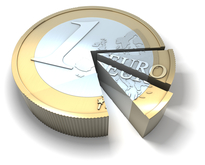In 2017, the gross domestic product (GDP) of the European Union (EU) amounted to €15 300 billion (bn) at current prices. Over half of it was generated by three Member States: Germany, the United Kingdom and France.
With a GDP worth almost €3 300bn last year, Germany reinforced its position as the leading EU economy, accounting for over a fifth (21.3%) of EU GDP. Although its share of the EU’s GDP decreased by 0.9 percentage points between 2016 and 2017, the United Kingdom (15.2%) retained its second position, just ahead of France (14.9%). They were followed by Italy (11.2%), Spain (7.6%) and the Netherlands (4.8%).
At the opposite end of the scale, eleven Member States had a GDP of less than 1% of the EU total. They were: Malta, Cyprus, Estonia, Latvia, Lithuania, Slovenia, Croatia, Bulgaria, Luxembourg, Slovakia and Hungary.
The source dataset can be found here.
The 19 Member States, which form the euro area, had a combined GDP of nearly €11 200 bn in 2017. The euro area accounted for 72.9% of the EU’s GDP. Germany (29.2%) and France (20.5%) together comprised half of the euro area GDP, while Italy (15.4%) and Spain (10.4%) made up a quarter.
For more information please contact us:


